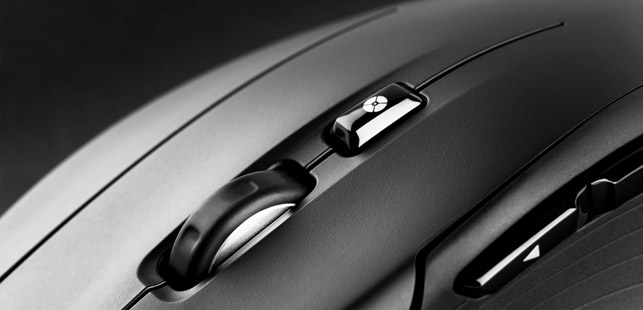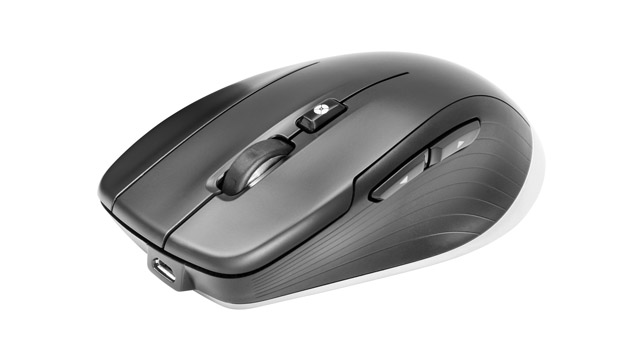CADMouse Wireless – The true three-button-mouse is a rare commodity. Realising this, 3DConnexion released the CADMouse in 2015 and this year it’s back with an updated version that adds wireless connectivity
These days, an input device designed specifically for the CAD community is a very rare thing indeed. More often than not, we’re accustomed to using general purpose tools for systems that have a different set of requirements. This is where 3DConnexion excels. It has good quality hardware along with a set of software that lets you tailor its products to your own workflows and often used commands.

The CADMouse Wireless is a well designed unit, both in terms of hardware and the all important drivers
So it was with some excitement that 3DConnexion released the CADMouse two years ago. It provided a cracking product that competed with other similarly priced products, but gave you a lot more options for customisation — as well as that all important third mouse button separate from the scroll wheel. The only issue for some (particularly those that travel or are fussy about a wire-free desktop), was that it was a corded product.
The new device is shipped with 3DConnexion’s usual attention to detail. Once you’ve opened up the box, extracted the device, the zip-up carry case (nice touch), cable and USB receiver, you’re ready to get things running.
Installation is a case of downloading the latest drivers and following instructions.
The mouse connects to your workstation in one of three ways. As you have probably assumed, this is a wireless variant of the original CADMouse.
The primary method uses 3DConnexion’s universal USB receiver dongle, so if you already have another of its wireless SpaceMouse products, this will connect to the one already in your machine. If not, it’ll use up one of your spare USB slots.
Alongside the wireless receiver connection, you also have a USB cable included. This is used for charging the mouse, but if you’re looking to run it while charging, you can — 3DConnexion has avoided Apple’s error with its Magic Mouse and the charge port is on the front of the unit, where you’d expect it.
In addition to these, the third option is via bluetooth. If you’re using a desktop workstation, chances are (unless you’ve retrofitted one), you’ll most likely use this for a portable machine.
Once the mouse is installed and ready, you can then use it as is or dive into the configuration settings.
This is one of 3DConnexion’s strong points — it has a pretty unique understanding of CAD applications and provides a rich set of tools for customising your mouse’s operations both at a system and application level. This applies to the main three buttons as it does the hot keys on the side of the unit.
CADMouse Wireless – customisation is key
The vast majority of us use more than one application during the working day — if not during the working minute. With multiple projects, multiple tasks and time pressures never higher, anything that can make your workflow that little bit more efficient is undoubtedly a good thing.
When it comes to input devices on your desk, you’re looking at a keyboard and a mouse. With keyboards in the 3D focussed design world, we’re all used to defining shortcuts and macros for those commonly used system inputs — whether that’s a quick save, starting a new sketch, a rotation of a model or switching display view methods.
Curiously, there are very few options for customisation. Yes, in many systems now you can switch your basic inputs and experiment with a few options. This is good for each individual application, but there’s not really a way to normalise your workflows. This is where 3DConnexion’s products always win big. Just as with the 3D controller devices (in fact, using the same software), you have the ability to customise a whole raft of options, from the core mouse buttons, to the side mounted hot keys to the smaller button just behind the scroll wheel (see image below).

Three buttons with the separate scroll wheel and SmartZoom button
Once you dive into the settings, you’ll find that this isn’t just a case of assigning new functions globally, but rather being able to define explicit functions on a per application basis.
Whether that’s a tweak to standard operations in a CAD system, assigning an OS level event (I have the forward side button assigned to create a screenshot on both Windows and PC) or even running a predefined macro.
All is there to play with. And the good news is that the defaults work nicely out of the box — use them as is or dive in and adapt them to your specific needs.
Handily, these configurations can also be exported and reimported into other machines, so you can have the same set-up on all machines you use the device with (and useful for keeping a back up).
In conclusion
Since it was released, I’ve used the CADMouse on my two key machines in the workshop — a desktop Windows box and a MacBook Pro. I’ve not had a single issue with either of them. While we’ve spent far less time with the CADMouse Wireless, it looks to be similarly impressive.
Comfort is a factor when you’re working with computers all day long. When it comes to CAD, you’re also looking for a mouse that can be customised (with this, there are a veritable feast of options), particularly if you’re looking to standardise interaction if you move between multiple applications. It’s pretty simple to set per application preferences so your mouse buttons do the same thing (however you want to do it).
In terms of comfort of use, the product is a scaled down version of the original CADMouse — I’d say around 20% smaller, which might make it more comfortable for those with smaller hands (the wired version is a beast). The good news is that this reduction in size hasn’t greatly affected the weight (it’s only lost 20g — presumably due to the battery).
When it comes to the benefits of the wireless product vs. the wired, the simple removal of the CADMouse’s wires makes it all the more suitable for use on the road. I’ve loved the wired version, but can rarely be bothered to unplug it and use it when travelling — leaving it in the workshop when I’m away, which might be a reflection on me, but I think it’s valid. You should also note that the form factor is a little smaller which is also ideal for travel — as is the supplied carry case.
The fact that, with this new version, you can leave the USB dongle in your workstation and connect your portable machine via Bluetooth when travelling means you can save both luggage and hassle.
Also, I think it’s worth noting that, while the price might seem a little high, it’s not inordinately more expensive than higherend mice (the benchmark is the Logitech MX range), but you get the benefit of greater CAD customisation, which you wouldn’t get with any other vendor’s products.
To my mind, that’s worth the small premium over more mainstream mouse choices out there.
| Product | CADMouse Wireless |
|---|---|
| Company name | 3DConnexion |
| Price | $99/£95 |






